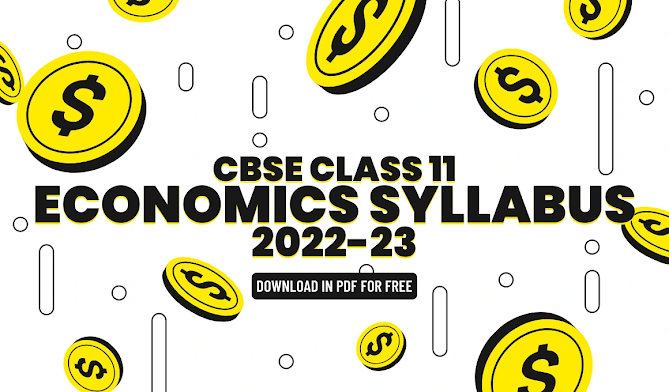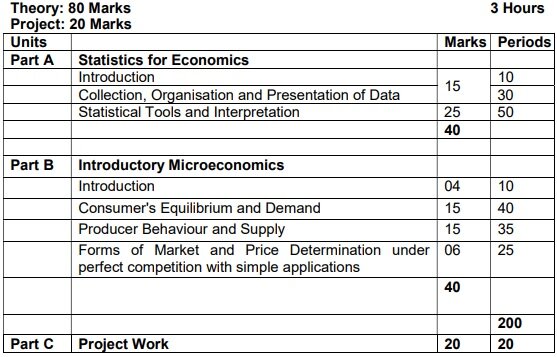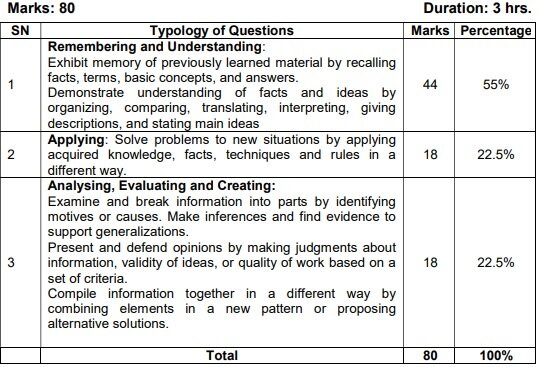CBSE Class 11 Economics Syllabus Syllabus 2022-2023 (Revised) is provided here in PDF format. Download the new syllabus to prepare for the CBSE Class 11 Economics Annual Exam 2022-2023 in the appropriate manner.
 |
| CBSE Class 11 Economics Syllabus 2022-2023 PDF |
Get here the CBSE Class 11 Economics Syllabus 2022-2023 in PDF format. This is the new syllabus that the board has released according to the revised assessment scheme for the current academic session. Some of the topics from the old syllabus have been removed. So, students should go through the new CBSE Class 11 Economics Syllabus to prepare the appropriate content for their annual exam and score good marks. They can also check here the Class 11 Economics Project Work details and the expected questions paper design for the CBSE Class 11 Economics Annual Exam 2022-23.
Check CBSE Class 11 Economics (Code No. 030) Course Structure 2022-23 below:

Check CBSE Class 11 Syllabus of All Subjects for 2022-2023 Session (PDF)
Part A: Statistics for Economics
In this course, the learners are expected to acquire skills in the collection, organization, and presentation of quantitative and qualitative information pertaining to various simple economic aspects systematically. It also intends to provide some basic statistical tools to analyze, and interpret any economic information and draw appropriate inferences. In this process, the learners are also expected to understand the behavior of various economic data.
Unit 1: Introduction (10 Periods)
What is Economics? Meaning, scope, functions, and importance of statistics in Economics
Unit 2: Collection, Organisation, and Presentation of data (30 Periods)
Collection of data - sources of data - primary and secondary; how basic data is collected with concepts of Sampling; methods of collecting data; some important sources of secondary data: Census of India and National Sample Survey Organisation.
Organization of Data: Meaning and types of variables; Frequency Distribution.
Presentation of Data: Tabular Presentation and Diagrammatic Presentation of Data:
(i) Geometric forms (bar diagrams and pie diagrams),
(ii) Frequency diagrams (histogram, polygon, and Ogive) and
(iii) Arithmetic line graphs (time series graph).
Unit 3: Statistical Tools and Interpretation (50 Periods) For all the numerical problems and solutions, the appropriate economic interpretation may be attempted. This means the students need to solve the problems and provide interpretation for the results derived.
Measures of Central Tendency - Arithmetic mean, median, and mode
Correlation - meaning, and properties, scatter diagram; Measures of correlation - Karl Pearson's method (two variables ungrouped data) Spearman's rank correlation.
Introduction to Index Numbers - meaning, types - wholesale price index, consumer price index and index of industrial production, uses of index numbers; Inflation and index numbers.
Part B: Introductory Microeconomics
Unit 4: Introduction (10 Periods)
Meaning of microeconomics and macroeconomics; positive and normative economics What is an economy? Central problems of an economy: what, how, and for whom to produce; concepts of production possibility frontier and opportunity cost.
Unit 5: Consumer's Equilibrium and Demand (40 Periods)
Consumer's equilibrium - meaning of utility, marginal utility, the law of diminishing marginal utility, conditions of consumer's equilibrium using marginal utility analysis.
Indifference curve analysis of consumer's equilibrium-the consumer's budget (budget set and budget line), preferences of the consumer (indifference curve, indifference map), and conditions of consumer's equilibrium.
Demand, market demand, determinants of demand, demand schedule, demand curve, and its slope, movement along and shifts in the demand curve; price elasticity of demand - factors affecting price elasticity of demand; measurement of price elasticity of demand – percentage-change method and total expenditure method.
Unit 6: Producer Behaviour and Supply (35 Periods)
Meaning of Production Function – Short-Run and Long-Run
Total Product, Average Product and Marginal Product.
Returns to a Factor
Cost: Short run costs - total cost, total fixed cost, total variable cost; Average cost; Average fixed cost, average variable cost, and marginal cost meaning and their relationships.
Revenue - total, average and marginal revenue - meaning and their relationship.
Producer's equilibrium-meaning and its conditions in terms of marginal revenuemarginal cost. Supply, market supply, determinants of supply, supply schedule, supply curve and its slope, movements along and shifts in supply curve, price elasticity of supply; measurement of price elasticity of supply - percentage-change method.
Unit 7: Forms of Market and Price Determination under Perfect Competition with simple applications. (25 Periods)
Perfect competition - Features; Determination of market equilibrium and effects of shifts in demand and supply. Simple Applications of Demand and Supply: Price ceiling, price floor.
Part C: Project in Economics (20 Periods)
(Check guidelines for project work in PDF below)
Suggested Question Paper Design for Class 11th Economics (Code No. 030) March 2023 Examination:

To download the full syllabus, click on the following link:
Download Syllabus in PDF